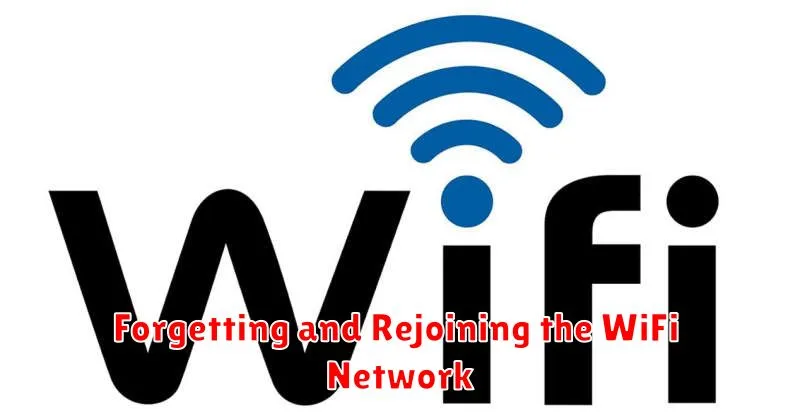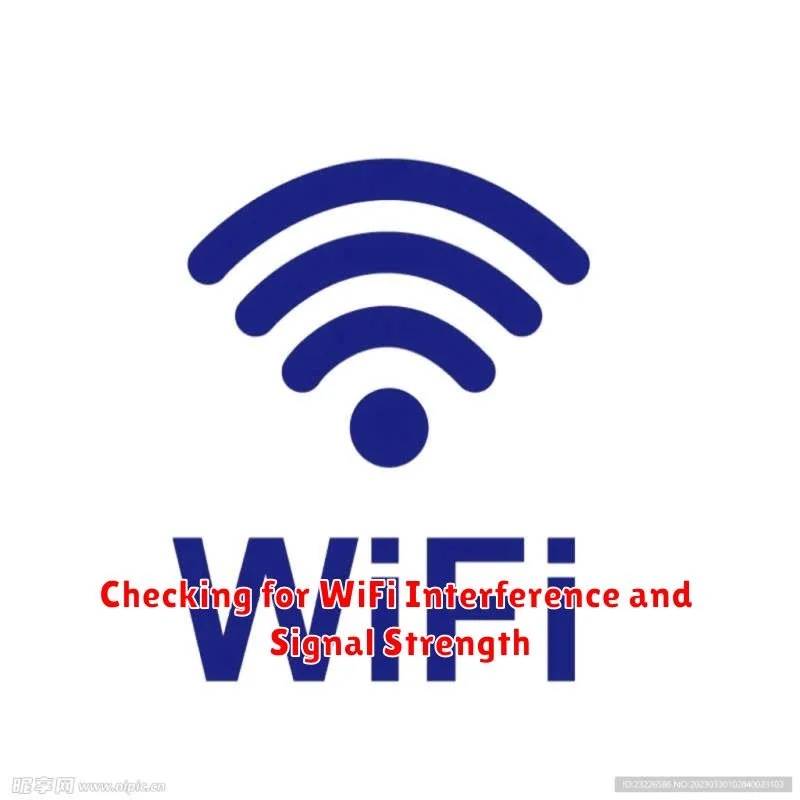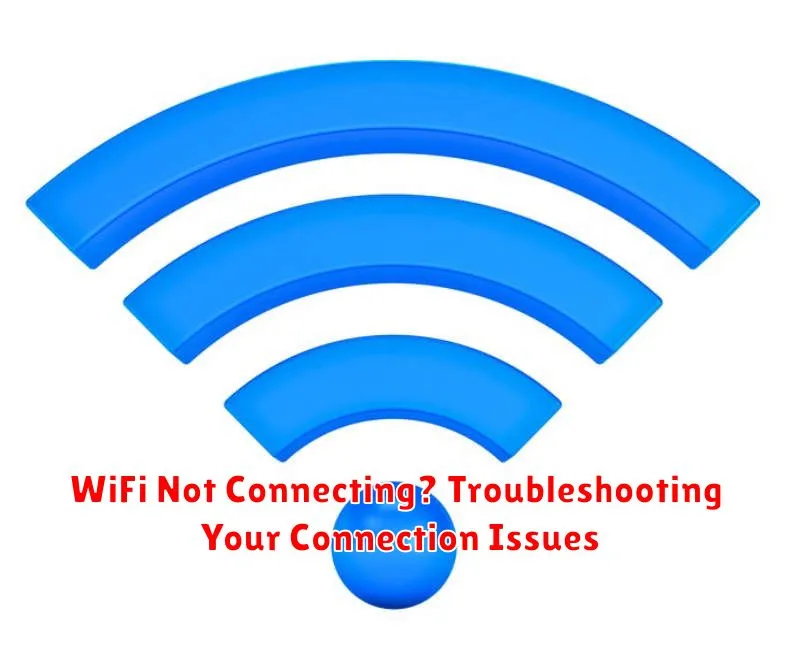Experiencing WiFi connection problems? Is your WiFi not connecting reliably, dropping frequently, or showing a “connected, no internet” message? A malfunctioning WiFi connection can be incredibly frustrating, disrupting work, entertainment, and communication. This comprehensive troubleshooting guide will address common causes of WiFi connectivity issues and provide step-by-step solutions to get you back online quickly. Whether you are struggling with a slow WiFi connection, intermittent outages, or complete connection failure, this guide will help you diagnose the problem and implement the appropriate fix.
From simple checks like verifying your WiFi password and restarting your router to more advanced troubleshooting techniques like checking for IP address conflicts and adjusting your DNS settings, we will cover a broad spectrum of potential solutions. This guide applies to various devices, including laptops, smartphones, tablets, and smart home devices. Learn how to effectively troubleshoot your WiFi not connecting issue and restore a strong, stable internet connection.
Identifying the Root Cause of WiFi Connection Problems
Before diving into solutions, it’s crucial to pinpoint the source of your WiFi woes. A systematic approach can save you time and frustration. Begin by determining if the issue lies with your device, router, or the internet connection itself.
Can other devices connect to the WiFi network successfully? If so, the problem likely resides with your specific device. If no devices can connect, the issue likely stems from the router or your internet service.
Observe any error messages displayed on your device. These messages can offer valuable clues. For instance, “Limited Connectivity” suggests a problem with IP address assignment, while “Incorrect Password” points to authentication issues. Note down these messages for later reference.
Consider the proximity of your device to the router. Signal strength weakens with distance and physical obstructions. If you’re far from the router, try moving closer to see if the connection improves.
Checking Your Router and Modem Settings
Often, the culprit behind WiFi connectivity problems lies within your router or modem settings. Accessing these settings requires connecting to your router, usually through an Ethernet cable, and then opening a web browser. The router’s IP address, typically 192.168.1.1 or 192.168.0.1 (though this can vary), needs to be entered in the browser’s address bar. You’ll be prompted for a username and password, which can be found on a sticker located on your router or in its documentation. If you’ve personalized these credentials, ensure you use those instead.
Once logged in, there are a few key settings to verify. Firstly, check that your router’s WiFi is enabled. It may seem obvious, but sometimes this setting can be accidentally toggled off. Next, confirm that the correct network name (SSID) and password are being used on your device. Typos are a common source of connection failures. Review the security protocol employed by your router (WPA2 or WPA3 are recommended for optimal security). Ensure your device supports the selected protocol.
Another crucial aspect to check is the router’s channel. Overlapping channels from neighboring WiFi networks can cause interference. Experimenting with different channels can often improve connection stability. You may find an option to automatically select the best channel, or you can manually choose one.
Troubleshooting WiFi Issues on Your Device
If the problem isn’t with your router or modem, the issue might reside within your device itself. Here’s a breakdown of troubleshooting steps specific to your device:
Airplane Mode
Ensure Airplane Mode is off. Accidentally enabling it will disable WiFi.
WiFi Toggle
Confirm that WiFi is enabled on your device. Sometimes the WiFi toggle can be inadvertently switched off.
Network List
Check if your device sees other available WiFi networks. If not, the device’s WiFi adapter might be malfunctioning. Consider restarting the device.
Previously Connected Networks
If your device has automatically connected to a different network with a weaker signal, manually select your preferred network from the list of available networks.
IP Address Conflict
Although less common, an IP address conflict could prevent connection. Restarting your device can often resolve this issue.
Restarting Your Devices: A Simple Yet Effective Fix
Sometimes, the simplest solution is the most effective. Restarting your devices can often resolve connectivity problems. This process clears temporary glitches and refreshes network configurations.
Begin by restarting your modem. Unplug the power cable, wait 30 seconds, and then plug it back in. Allow a few minutes for the modem to fully reboot. Observe the lights on the modem to ensure it’s online.
Next, restart your router. Follow the same procedure as with the modem: unplug, wait, and plug back in. Once the router is back online, check its indicator lights.
Finally, restart the device you’re trying to connect to the WiFi. Whether it’s a laptop, smartphone, or tablet, a simple restart can often resolve connection issues.
Forgetting and Rejoining the WiFi Network

Sometimes, the simplest solutions are the most effective. Forgetting and rejoining your WiFi network can resolve connection issues stemming from corrupted network profiles or minor software glitches on your device. This process forces your device to establish a fresh connection with the network.
Forgetting the Network: This process varies slightly depending on your operating system (e.g., Windows, macOS, Android, iOS). Generally, you’ll access your WiFi settings, locate the network you’re having trouble with, and select the option to “forget” or “remove” the network. This deletes the saved network credentials from your device.
Rejoining the Network: After forgetting the network, rescan for available WiFi networks. Select your network from the list and enter the correct password when prompted. This re-establishes the connection with a fresh configuration.
Note: Ensure you have the correct WiFi password before forgetting the network. If you don’t remember the password, you may need to access your router’s settings or contact your internet service provider.
Checking for WiFi Interference and Signal Strength

Wireless interference can significantly impact your WiFi connection. Household appliances like microwaves, cordless phones, and Bluetooth devices can operate on similar frequencies, disrupting your WiFi signal. Additionally, physical obstacles such as walls and furniture can weaken the signal, especially in larger homes.
To check for interference, try temporarily turning off nearby electronic devices and observe if your WiFi performance improves. If it does, you’ve identified a potential source of interference. Relocating the interfering device or your router may resolve the issue.
Signal strength also plays a vital role in connection stability. Most devices display WiFi signal strength through an icon or bars. A weak signal, indicated by fewer bars, can lead to slow speeds and intermittent connectivity. Moving closer to your router or using a WiFi range extender can help boost the signal strength.
You can also use free WiFi analyzer apps available on most smartphones and computers. These apps provide detailed information about nearby WiFi networks, including their signal strength and channels. Identifying overlapping channels can help you optimize your router’s channel selection for better performance.
Updating WiFi Drivers and Firmware
Outdated or corrupted WiFi drivers and firmware can often lead to connection problems. Ensuring these are up-to-date is a crucial step in troubleshooting.
Updating WiFi Drivers (Computer)
WiFi drivers facilitate communication between your operating system and the WiFi adapter. To update them:
- Open the Device Manager (search for it in your system’s search bar).
- Expand the Network adapters section.
- Right-click on your WiFi adapter (it will likely have “Wireless” or “WiFi” in its name).
- Select Update driver.
- Choose Search automatically for drivers.
Updating Router Firmware
Router firmware is the software that controls your router. Check your router manufacturer’s website for instructions specific to your model. Generally, the process involves:
- Accessing your router’s admin interface through a web browser (usually by entering 192.168.1.1 or 192.168.0.1 in the address bar).
- Locating the Firmware Update or similar section.
- Following the on-screen instructions to download and install the latest firmware.
Important: Do not interrupt the firmware update process, as this could damage your router.
Contacting Your Internet Service Provider for Further Assistance
If you’ve exhausted all troubleshooting steps and your WiFi still isn’t connecting, it’s time to contact your Internet Service Provider (ISP). They can diagnose problems related to your internet service or any outages in your area.
Before contacting your ISP, gather the following information to expedite the troubleshooting process:
- Your account number.
- The model names of your modem and router.
- A description of the troubleshooting steps you’ve already taken.
- The specific error messages you’re encountering, if any.
Your ISP can remotely check the connection status and signal strength, and they may be able to identify issues you can’t detect yourself. They might also offer specific advice or schedule a technician visit if necessary.
Remember to clearly describe the problem and be prepared to answer their questions to help them resolve your connection issues effectively.
Advanced Troubleshooting Tips for Persistent WiFi Issues
If you’ve exhausted basic troubleshooting steps and your WiFi still isn’t connecting reliably, these advanced techniques might help.
Checking for IP Address Conflicts
Sometimes, two devices on the same network may be assigned the same IP address, leading to conflicts. Try releasing and renewing your device’s IP address through your operating system’s network settings. You may also try assigning a static IP address outside the range assigned by your DHCP server (consult your router’s documentation for this range).
Analyzing Network Traffic with a Packet Analyzer
Tools like Wireshark can capture and analyze network traffic, helping identify underlying issues like excessive dropped packets or network congestion. This requires some technical knowledge to interpret the results effectively.
Adjusting Router Channel Settings
WiFi routers operate on different channels. Overlapping channels with neighboring networks can cause interference. Access your router’s settings and try switching to a less congested channel (typically channels 1, 6, or 11 for 2.4 GHz networks).

